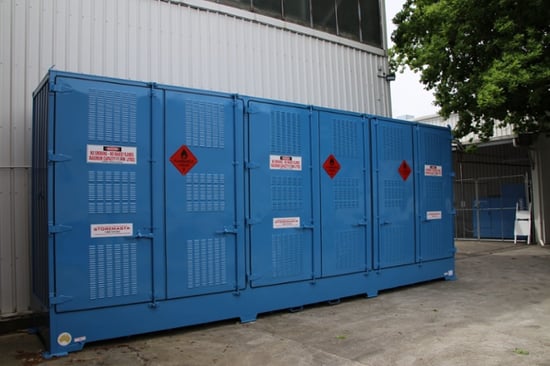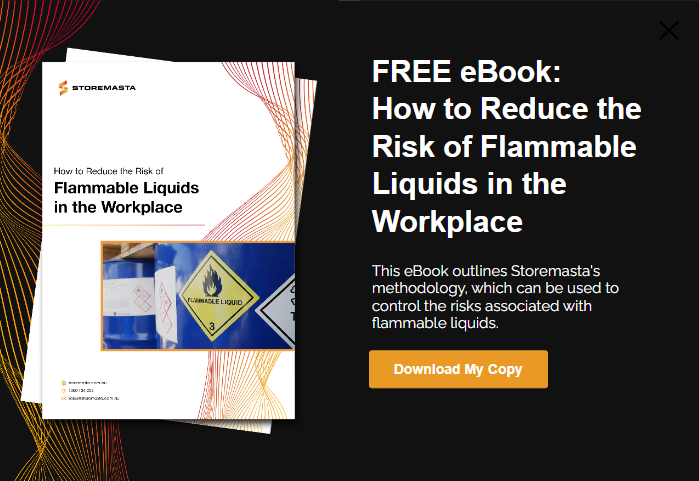With a team of Field Auditors who visit workplaces across the country, you can guarantee that we’ve seen some strange (and often dangerous) flammable liquids storage practices. From containers of flammable liquids left on the ground next to the safety cabinet (because the cabinet was full!) to piles of combustibles and non-hazardous substances stacked in the cabinet, you’d be surprised to know how Class 3 chemicals are being kept. If you’re a business that uses Class 3 Flammable Liquids, it’s vital that you prioritise the safe and compliant storage of your chemicals.
As an extremely volatile liquid, these hazardous substances emit large amounts of flammable vapours — at room temperatures. And if these vapours meet an ignition source or incompatible chemical, your workplace could experience a devastating fire or explosion. To reduce your risks, we’re highlighting some key flammable liquid storage requirements that you can easily apply to your own organisation. These requirements include the provision of compliant storage, the isolation of ignition sources, ensuring adequate ventilation, issuing the correct PPE for your staff, and making sure you have the current safety data sheets for stored substances.
After all, when you’re carrying dangerous goods, meeting your chemical compliance obligations can be the difference between a safe workplace — and a dangerous one.
Store Flammable Liquids in a Compliant Cabinet or Store
Flammable liquids must be stored in a flammable liquids storage facility that has been constructed in full conformance to the Australian Standards.
Safety cabinets and outdoor chemical storage containers that are used for the storage of flammable liquids must be designed and manufactured in full conformance to AS 1940. The standard details all the specific requirements for the design of flammable liquids cabinets and storage facilities.
Whether you're storing Class 3 liquids inside or outside, it's best practice to choose compliant Class 3 storage.
Requirements for flammable liquids storage in AS 1940 include factors such as construction materials, spill containment, dangerous goods signage, ventilation and chemical segregation. By choosing a compliant flammable cabinet or store — and ensuring it’s installed, used and maintained in the correct manner — you can feel confident that you’re meeting your chemical compliance obligations.
REMEMBER: It’s a requirement of Section 363 of Australian WHS Regulations to ensure that any system installed at the workplace for storing hazardous chemicals (such as a Class 3 cabinet) is only used for the purpose for which it was designed and manufactured (ie. storing flammable liquids).
Isolate Ignition Sources from Flammable Liquids
Flammable liquids, due to their low flash point and flammable vapours, have the potential to cause serious fires in a work environment.
To prevent flammable liquids fires, you must always ensure that stores of Class 3 Dangerous Goods are separated from ignition sources. This also includes any areas that carry or handle flammable liquids.
The Australian Standard AS 1940 – The storage and handling of flammable and combustible liquids outlines the storage requirements for this dangerous goods class.
Flammable liquids storage facilities must be segregated from ignition sources by a distance of at least 3 metres. However, knowing how to identify an ignition source may not always be a straightforward process.

You must isolate ignition sources from any area that is handling or storing flammable liquids due to the serious risk of fire, flashback and explosion.
Types of Ignition Sources
The key types of ignition sources are thermal, electrical, mechanical and chemical.
Some common examples of ignition sources that may be present in workplaces include:
- Grinding and welding sparks
- Soldering iron
- Power points
- Pilot Light
- Electric motor
- Glowing embers
- Cigarette lighter
- Arc Weld
- Lightning strike
To minimise fire hazards in your workplace, it is important to carry out a dangerous goods risk assessment to ensure that all flammable liquids storage cabinets are separated from ignition sources by a distance of at least 3 metres.
Segregate Flammable Liquids from Incompatible Substances
When determining where to store flammable liquids in the workplace, you must consider the fact that there may be other substances in the workplace that are incompatible with flammable liquids.
Of the 9 Classes of Dangerous Goods, there are many substances that are incompatible with flammable liquids. These substances must be segregated to avoid violent chemical reactions.
Violent chemical reactions between flammable liquids and other incompatible substances can cause fires and explosions — which, in turn, produce pungent corrosive and toxic vapours.
To avoid these hazardous incidents, flammable liquids must be stored in a location that is well away from other incompatible chemicals. The correct segregation distances for safely storing flammable liquids with incompatible chemicals can be determined with a dangerous goods segregation chart, but a general rule is to keep flammable liquids at least 3 to 5 metres away from any incompatible chemicals.
Like to learn more about safe chemical storage?
Shop our eBook for just $6.99 + GST
Keep Flammable Liquids Away from Protected Places
To effectively reduce risk, flammable liquids storage facilities must be separated from protected places.
According to AS 1940, a protected place is defined as:
A dwelling, residential building, place of worship, public building, school or college, hospital, theatre, and any building or open area in which persons are accustomed to assemble whether it is within or outside the property boundary of the installation.
The required separation distance of flammable liquids storage facilities from protected places depends on the quantity and the packing group of the flammable liquids that are being stored.
You’ll find details of the required separation distances on table 4.1 in Section 4 of AS 1940.
Keep Storage and Handling Areas Ventilated
As we’ve already explained in this blog, Class 3 Flammable Liquids give off large quantities of flammable vapours. These vapours can have many negative health effects upon the people in the workplace. If large quantities of flammable vapours are inhaled by staff, they can suffer from nausea, headaches and asphyxiation.
To reduce the risk of human harm that flammable vapours pose in workplaces, you must store flammable liquids in a well-ventilated area. Your workplace must keep vapours at a level that is below the workplace exposure standards, otherwise, you’ll be facing financial liability due to non-compliance.
Are you concerned that the concentration of flammable vapours within your flammable liquids storage cabinets exceed the workplace exposures standards? Then the solution may be to install a mechanical ventilation system to safely dissipate these hazardous vapours.
Supply and Maintain the Correct PPE for Class 3 Substances
Workers who decant or handle flammable liquids require personal protective equipment (PPE). This is to protect workers’ eyes, face, hands, ears, feet, — and other parts of the body from being splashed or exposed to hazardous chemicals.
You can determine your personal protective equipment requirements by reviewing each safety data sheet for the flammable liquids at your site. In addition to this guidance, you can also turn to the Australian Standard which offers general guidelines for the personal protective equipment required for flammable liquids.
This includes:
- Protective clothing
- Eye protection
- Protective gloves
- Safety helmets
- Safety footwear
- Respirators and self-contained breathing apparatus
IMPORTANT: Suitable personal protective equipment must comply with the relevant regulations, be fit-for-purpose, in good condition and a good fit for the staff who are wearing the equipment.
Storing Personal Protective Equipment
In addition to these PPE requirements, it’s also essential to keep your personal protective equipment in a designate location that is well-identified and easy to access.
Naturally, your staff need their PPE and protective clothing to be on hand as they carry out their duties. However, you should never store PPE inside the flammable liquids cabinet.
Personal protective equipment for flammable liquids should be kept in a dedicated PPE cabinet, so your team can quickly and safely access the required equipment for their daily tasks.
REMEMBER: Storemasta manufactures PPE storage cabinets to help maintain the safety and longevity of your personal protective equipment. These PPE cabinets are constructed from heavy duty sheet steel and finished with a high build powder coat that helps protect the cabinet from corrosion.
Store Current Safety Data Sheets
As we’ve mentioned in this post, your safety data sheets are the key source of information about the hazards and requirements associated with your Class 3 Flammable Liquids.
When keeping safety data sheets at your workplace, you must ensure that they are current – which means no more than 5 years old. They must also be made available to your staff, in addition to any emergency services that may have to attend your site.
The easiest way to achieve compliance with safety data sheets is to make sure that they’re kept in a clearly marked static location. We recommend storing your safety data sheets in a waterproof document holder, and attaching this to your flammable liquids cabinet or store.
Are You Meeting the Flammable Liquids Storage Requirements?
So, how are you storing your flammable liquids? As we’ve highlighted in this blog, a safe and compliant location for your flammable liquid stores will offer adequate ventilation and be separated from ignition sources, protected places and incompatible chemicals.
Are you interested in reducing your risk? Then click on the image below to access our free eBook. How To Reduce The Risk Of Flammable Liquids In The Workplace offers easy-to-understand advice about how you can make your workplace safe and compliant.
This resource also details the Storemasta 4-Step Risk Management Methodology, IDENTIFY – ASSESS – CONTROL – SUSTAIN, that you can apply to your own organisation. Download your copy to learn more.
Joining the team as a Dangerous Goods Storage Consultant, Melissa Hampton became Storemasta's Marketing Manager in late 2021. With extensive knowledge and experience in chemical compliance, Melissa is responsible for leading the Marketing team and helping shape their marketing strategy. In her spare time, you can find Melissa hiking, swimming and enjoying the great outdoors in beautiful north-west Tasmania.


